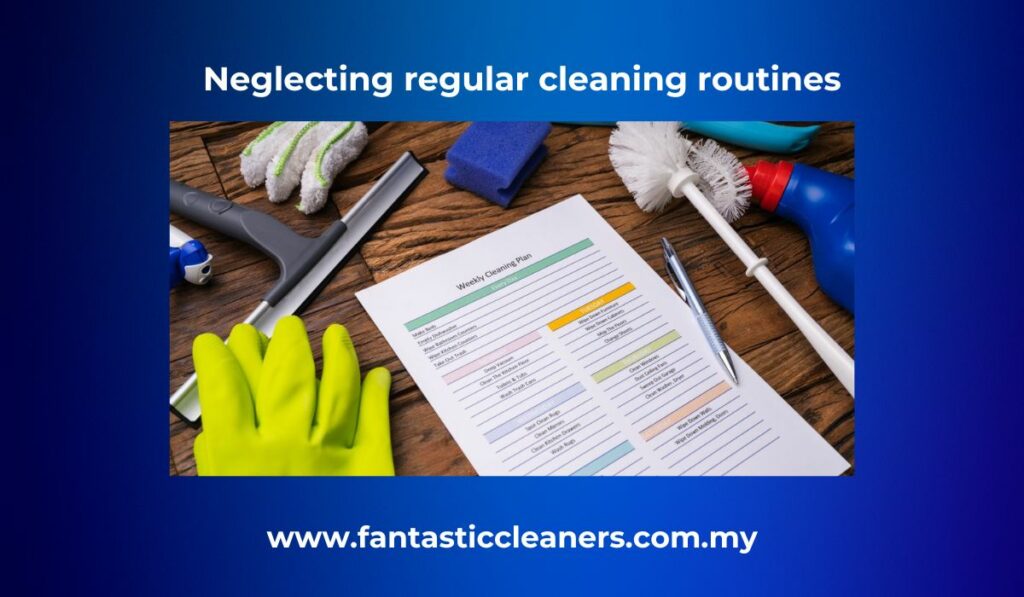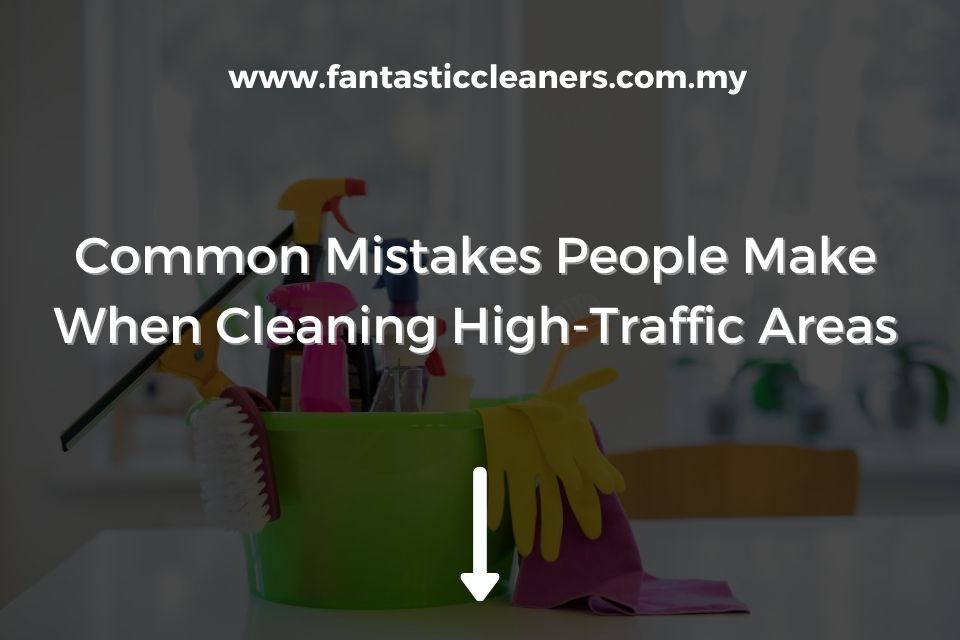Have you ever dedicated several hours to cleaning a frequently used area, only to find it seems even messier afterward? You’re in good company! To truly maximize the efficiency of your cleaning efforts in areas that see a lot of use, it’s important to steer clear of common pitfalls. With our helpful advice, you can achieve a clean and orderly space.
Table of Contents
Neglecting regular cleaning routines

The absence of regular cleaning can lead to debris buildup in heavily trafficked areas. This can bring about unpleasant odors, bacteria levels rising, and flooring or furniture damage. Neglecting maintenance of high-traffic zones not only impacts the look of your space, but also the safety and health of those frequenting it.
Failing to clean these areas regularly increases expenses. To prevent this, make a routine and stick to it. Also, using wrong cleaning products can worsen the situation – like trying to douse a fire with gasoline.
Using the wrong cleaning products
People make mistakes when cleaning high-traffic areas, leading to a dull and dirty look. Errors usually occur when the wrong cleaning products are used. Common mistakes include using strong chemicals on surfaces – this can harm materials and the environment.
It’s better to go for natural or specific cleansers designed for high-traffic areas. Utilizing microfiber cloths or mops help remove dirt without causing harm.
Also, remember that different materials need different cleaners. For example, wood needs its own type of cleanser, and plastic needs non-abrasive cleansers.
When you take these precautions when selecting cleaning products, it can save time and money – and give people a clean and glossy appearance in high-traffic areas. The key is to choose the right cleaning products.
Not paying attention to details
Pay close attention to every detail when cleaning busy areas. Look into crevices, corners, and cracks for germs, dirt, and dust. Use a brush or scrubber to make sure everything is clean.
Ignoring overlooked spaces can lead to bad odors and allergies. Disinfect all high-touch areas frequently. Knobs, handles, light switches, chairs, and counters must not be neglected when cleaning. Ventilation is also important. Make sure to have windows open to let out any residual chemicals and to help dry surfaces.
Don’t get careless while cleaning; otherwise, your areas will resemble a crime scene!
Rushing through the cleaning process
When cleaning areas with high foot traffic, rushing can lead to mistakes and unsatisfactory results. Follow these five guidelines for thorough cleaning without rushing:
| 1. | Organize your supplies before starting. |
|---|---|
| 2. | Plan an efficient route. |
| 3. | Make a checklist. |
| 4. | Use multiple workers if needed. |
| 5. | Focus on one job at a time. |
Neglecting these methods can lead to blunders such as: using dirty water, not rinsing, skipping vacuuming, not using enough detergent, not illuminating corners, etc. Stick to these steps to ensure the best outcome in places like waiting rooms, lobbies, or busy marketplaces. Check those hidden spots too—you never know what dust bunnies are up to!
Overlooking hidden nooks and corners
Cleaning high-traffic areas isn’t just sweeping and mopping. Ignoring corners and crevices can cause dust, grime, and even mold and bacteria. This poses health risks. It’s essential to clean these areas to keep air quality good, stop the spread of respiratory illnesses, and make the space look better.
Don’t forget to clean behind doors, under furniture, light fixtures, switches, and vents. Cleaning these spots helps you do a thorough job. If you wait too long to clean a stain, it won’t go away!
Failing to remove stains promptly
Stains that aren’t taken care of straight away can cause major issues in high-traffic areas. These tough spots can become embedded deep into carpets or surfaces, leading to permanent staining. In such cases, trying to get rid of the stain later requires lots of time, effort and money.
If you don’t act fast, the stain will spread over a larger area. Dirty footprints and spilled liquids often move around quickly in high-traffic areas. This just makes the problem worse, leaving marks that are harder to clean once they’ve been neglected for a while.
Not dealing with stains can also cause bacteria and mold growth, which can have an effect on hygiene – especially in restaurants or public restrooms.
Failing to clean up stains quickly is a mistake often made by those responsible for maintaining high-traffic spaces. With so much going on in these areas, regular maintenance is vital for keeping places clean and smelling fresh.
Cleanliness may be a virtue, but avoiding high-touch surfaces means you’re headed straight for germsville.
Ignoring high-touch surfaces
High-touch surfaces are often neglected when cleaning, which leads to the spread of germs and bacteria. It’s important to focus on places with a lot of foot traffic. Not looking after these surfaces can cause health issues, so it’s essential to address it as soon as possible.
Here’s 6 tips to remember:
- Don’t forget door handles and knobs – people touch them often.
- Sanitize electronics like keyboards, mouses and phones to reduce the spread of germs.
- Clean shared spaces, like restrooms, with the right products, regularly.
- Wash kitchen objects, cupboards and counters often – germs love them!
- Clean children’s toys regularly – they can spread diseases quickly.
- Disinfect gym equipment often – many people use them.
Also, neglecting any surface is not only bad for you, but for those around you too. So, take a comprehensive approach when cleaning and don’t forget high-traffic areas; unless you like the taste of dirt in your cereal!
Neglecting regular vacuuming
Regular vacuuming is often forgotten when it comes to high-traffic areas. Ignoring this key step can lead to a buildup of dirt and debris that can be hard to remove later.
Also, neglecting regular vacuuming can cause damage to carpets or flooring, shortening their lifespan and making replacements more costly.
Cleaning high-traffic areas well needs regular vacuuming. Plus, spills and stains need to be spot cleaned right away. This stops them from becoming stuck in the fibers or flooring, making them harder to remove later.
To wrap it up, having a regular cleaning routine that involves vacuuming and spot cleaning will keep high-traffic areas looking great for years. If you can’t do it yourself, it’s best to call in the experts!
Not hiring a professional cleaning company
Cleanliness and hygiene are important. Hiring professional cleaning company for high-traffic areas is a must! Neglecting this can cause germs and bacteria to spread, and increase the risk of illnesses. Inexperienced cleaners can cause damage or not do a good job. This leads to time-consuming and costly clean-up processes.
But, experts have special tools and modern techniques for a hygienic setting without compromising quality. Avoid the horror of dirty floors and OCD by avoiding these mistakes. Get professional help!
Conclusion
High-traffic areas need special care when cleaning; otherwise, germs and bacteria can build up and create health risks. To do it right, use the proper techniques and equipment. For example, microfiber cloths and rotating mop heads can help reduce dirt. Also, keep a regular cleaning schedule to stop dust and dirt from accumulating.
Moreover, eco-friendly cleaning solutions not only save money but also help the environment. Don’t use harsh chemicals that can hurt humans. Always follow safety instructions when using cleaning agents to stay safe.
Remember that high-traffic areas need frequent deep-cleaning more often than other low-traffic areas. Installing mats at entry points is a good way to lower debris buildup. With proper maintenance and following thorough cleaning practices, you can keep high-traffic sections clean and maintain a healthy environment.
Frequently Asked Questions
What is a high-traffic area?
A high-traffic area is a spot in a building that sees a lot of foot traffic, such as entrances, hallways, and common spaces.
What are some common mistakes people make when cleaning high-traffic areas?
Some common mistakes include using too much cleaning solution, neglecting to vacuum or sweep regularly, and not cleaning up spills and stains promptly.
Why is it important to clean high-traffic areas properly?
Cleaning high-traffic areas is important for maintaining the health and safety of building occupants, as well as prolonging the lifespan of the flooring and other surfaces in the area.
How often should high-traffic areas be cleaned?
High-traffic areas should be cleaned daily to prevent the build-up of dirt, dust, and grime.
What types of cleaning products should be used in high-traffic areas?
It is important to use cleaning products that are safe for the surfaces being cleaned and do not leave behind a slippery residue that could pose a safety hazard.
What equipment is necessary for cleaning high-traffic areas?
Equipment such as a high-quality vacuum, mop and bucket, microfiber cloths, and cleaning solutions appropriate for the type of flooring and surface in the area are necessary for effective cleaning in high-traffic areas.

